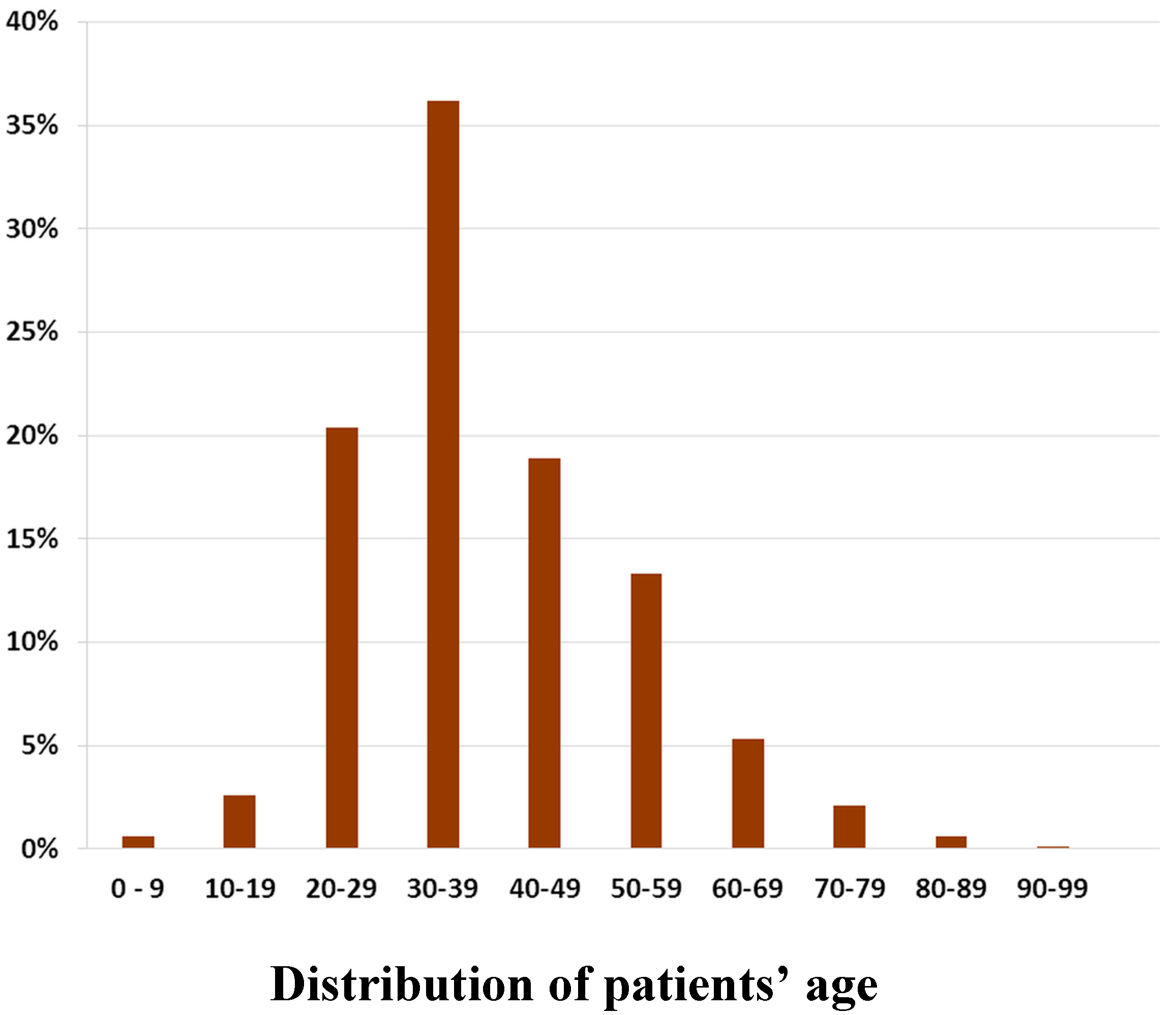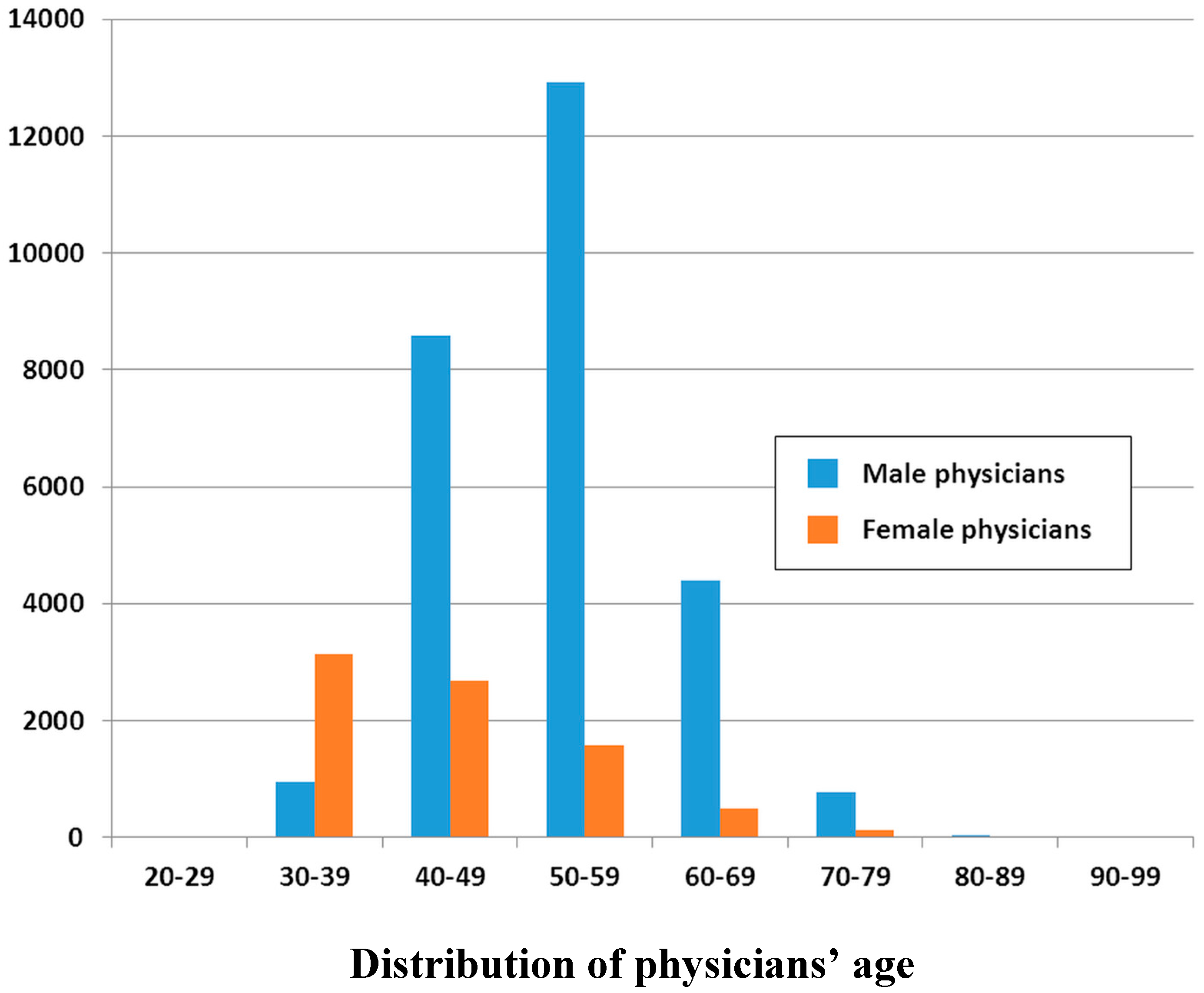Pattern of Ambulatory Care Visits to Obstetrician-Gynecologists in Taiwan: A Nationwide Analysis
Abstract
:1. Introduction
2. Methods
2.1. Database
2.2. Study Population
2.3. Statistical Analysis
3. Results
| Specialty | Number of visits (%) | Claims (%) |
|---|---|---|
| Family medicine | 116,551 (18.8) | 51,157,561 (8.3) |
| Internal medicine | 70,615 (11.4) | 42,542,879 (6.9) |
| Otorhinolaryngology | 67,881 (11.0) | 29,718,395 (4.8) |
| Pediatrics | 60,717 (9.8) | 31,574,986 (5.1) |
| Ophthalmology | 37,692 (6.1) | 25,422,291 (4.1) |
| Obstetrics & Gynecology | 35,697 (5.8) | 19,674,700 (3.2) |
| All others | ||
| Total | 619,760 (100) | 618,119,592 (100) |


| ICD-9CM * | Diagnosis group | Total N = 35,697 ** | Academic medical center N = 3402 | Metropolitan hospital N = 4945 | Local community hospital N = 5365 | Physician clinics N = 21,974 |
|---|---|---|---|---|---|---|
| 626 | Disorders of menstruation | 4667 (13.1) | 129 (3.8) | 340 (6.9) | 617 (11.5) | 3581 (16.3) |
| V22 | Normal pregnancy | 4443 (12.4) | 617 (18.1) | 1134 (22.9) | 1065 (19.9) | 1627 (7.4) |
| 616 | Inflammatory disease of the cervix, vagina, and vulva | 4431 (12.4) | 127 (3.7) | 313 (6.3) | 572 (10.7) | 3419 (15.6) |
| V76 | Special screening for malignant neoplasms | 2374 (6.7) | 312 (9.2) | 744 (15.04) | 485 (9.0) | 823 (3.74) |
| V72 | Special investigations & examinations | 1677 (4.7) | 179 (5.3) | 176 (3.6) | 207 (3.9) | 1115 (5.1) |
| Unknown | 1559 (4.4) | 0 (0.0) | 5 (0.1) | 1 (0.01) | 1552 (7.1) | |
| 789 | Other symptoms involving abdomen | 1512 (4.2) | 56 (1.6) | 137 (2.8) | 253 (4.7) | 1066 (4.9) |
| 627 | Menopausal disorders | 1293 (3.6) | 180 (5.3) | 326 (6.6) | 242 (4.5) | 545 (2.5) |
| 614 | Inflammatory disease of ovary, pelvic tissue | 900 (2.5) | 30 (0.88) | 51 (1.0) | 83 (1.5) | 736 (3.3) |
| 112 | Candidiasis | 676 (1.9) | 11 (0.3) | 27 (0.5) | 82 (1.5) | 556 (2.5) |
| NHI Code | Procedure | No. of visits | % |
|---|---|---|---|
| 55021C | Pelvic examination | 6,774 | 19.0% |
| 33 | Cervical pathology | 4,536 | 12.7% |
| 55011C | Vaginal irrigation | 4,058 | 11.4% |
| 31 | Pap smear sampling/pelvic examination | 3,653 | 10.2% |
| 19003C | Gynecologic ultrasound | 2,802 | 7.8% |
| 06505C | Pregnancy test—enzyme immunoassays | 2,188 | 6.1% |
| 06012C | General urine examination | 825 | 2.3% |
| 19010C | Obstetric ultrasound | 568 | 1.6% |
| 41 | First trimester prenatal visits | 478 | 1.3% |
| 64 | Rubella IgG test | 460 | 1.3% |
| ATC Code | Drug classification | No. of visits | % |
|---|---|---|---|
| G01A | Anti-infectives | 5402 | 15.1% |
| M01A | Anti-inflammatory, non-steroids | 3754 | 10.5% |
| N02B | Other analgesics and anti-pyretics | 2884 | 8.1% |
| G03D | Progestogens | 2871 | 8.0% |
| A02A | Antacids | 2683 | 7.5% |
| D07C | Corticosteroids, combinations with antibiotics | 2090 | 5.9% |
| R06A | Antihistamines for systemic use | 1932 | 5.4% |
| A03A | Drugs for functional bowel disorders | 1866 | 5.2% |
| J01D | Other beta-lactam anti-bacterials | 1863 | 5.5% |
| G03C | Estrogens | 1837 | 5.1% |
4. Discussion
5. Conclusions
Acknowledgments
Author Contributions
Conflicts of Interest
References
- Ide, H.; Yasunaga, H.; Kodama, T.; Koike, S.; Taketani, Y.; Imamura, T. The dynamics of obstetricians and gynecologists in Japan: A retrospective cohort model using the nationwide survey of physicians data. J. Obstet. Gynaecol. Res. 2009, 4, 761–766. [Google Scholar] [CrossRef] [PubMed]
- Rayburn, W.F.; Strunk, A.L.; Petterson, S.M. Considerations about retirement from clinical practice by obstetrician-gynecologists. Am. J. Obstet. Gynecol. 2015. [Google Scholar] [CrossRef] [PubMed]
- American College of Obstetricians and Gynecologists. Available online: http://www.acog.org/Resources-And-Publications/Committee-Opinions/Committee-on-Health-Care-for-Underserved-Women/Health-Disparities-in-Rural-Women (accessed on 5 April 2015).
- Wang, P.H.; Sheu, B.C.; Yeh, J.Y. The sunset industry: Obstetrics and gynecology concerns about the shortage of obstetricians and gynecologists. Am. J. Obstet. Gynecol. 2009. [Google Scholar] [CrossRef] [PubMed]
- Ezzat, T. Office visits to obstetrician-gynecologists, National Ambulatory Medical Care Survey, 1975. Adv. Data 1978, 37, 1–7. [Google Scholar]
- Cypress, B.K. Patterns of ambulatory care in obstetrics and gynecology: The national ambulatory medical care survey, United States, January 1980–December 1981. Vital Health Stat. 1984, 76, 1–62. [Google Scholar]
- Schappert, S.M. Office visits to obstetricians and gynecologists, US 1989–90. Adv Data 1993, 223, 1–16. [Google Scholar] [PubMed]
- Hill, L.D.; Erickson, K.; Holzman, G.B.; Power, M.L.; Schulkin, J. Practice trends in outpatient obstetrics and gynecology findings of the Collaborative Ambulatory Research Network, 1995–2000. Obstet. Gynecol. Survey 2001, 8, 505–516. [Google Scholar] [CrossRef]
- Coleman, V.H.; Power, M.L.; Zinberg, S.; Schulkin, J. Contemporary clinical issues in outpatient obstetrics and gynecology findings of the Collaborative Ambulatory Research Network 2001–2004 Part I. Obstet. Gynecol. Survey 2004, 11, 780–786. [Google Scholar] [CrossRef]
- Coleman, V.H.; Power, M.L.; Zinberg, S.; Schulkin, J. Contemporary clinical issues in outpatient obstetrics and gynecology findings of the Collaborative Ambulatory Research Network 2001–2004 Part II. Obstet. Gynecol. Survey 2004, 11, 787–794. [Google Scholar] [CrossRef]
- The Guardian. Taiwan Offers Baby Bonus to Fix Plummeting Birth Rate. Available online: http://www.theguardian.com/world/2012/jan/23/taiwan-low-birth-rate (accessed on 6 June 2015).
- Lee, R.; Mason, A.; members of the NTA Network. Is low fertility really a problem? Population aging, dependency, and consumption. Science 2014, 346, 229–234. [Google Scholar] [CrossRef] [PubMed]
- Lin, Y.C.; Pan, W.H. Bone mineral density in adults in Taiwan: Results of the Nutrition and Health Survey in Taiwan, 2005–2008 (NAHSIT 2005–2008). Asia Pac. J. Clin. Nutr. 2011, 20, 283–291. [Google Scholar] [PubMed]
- Hwang, J.S.; Chan, D.C.; Chen, J.F.; Cheng, T.T.; Wu, C.H.; Soong, Y.K.; Tsai, K.S.; Yang, R.S. Clinical practice guidelines for the prevention and treatment of osteoporosis in Taiwan: Summary. J. Bone Miner Metab. 2014, 32, 10–16. [Google Scholar] [CrossRef] [PubMed]
- Chen, G.D.; Lin, T.L.; Hu, S.W.; Chen, Y.C.; Lin, L.Y. Prevalence and correlation of urinary incontinence and overactive bladder in Taiwanese women. Neurourol. Urodyn. 2003, 2, 109–117. [Google Scholar] [CrossRef] [PubMed]
- Tseng, L.H.; Liang, C.C.; Lo, H.P.; Lo, T.S.; Lee, S.J.; Wang, A.C. The prevalence of urinary incontinence and associated risk factors in Taiwanese women with lower urinary tract symptoms. Chang Gung Med. J. 2006, 6, 596–602. [Google Scholar]
- Chia, P.C.; Chou, C.L.; Chou, Y.C.; Shao, C.C.; Su, H.I.; Chen, T.J.; Chou, L.F.; Yu, H.C. The ecology of gynecological care for women. Int. J. Environ. Res. Public Health 2014, 8, 7669–7677. [Google Scholar]
- Huang, N.; Chou, Y.J.; Chang, H.J.; Ho, M.; Morlock, L. Antibiotic prescribing by ambulatory care physicians for adults with nasopharyngitis, URIs, and acute bronchitis in Taiwan: A multi-level modeling approach. Fam. Pract. 2005, 22, 160–167. [Google Scholar] [CrossRef] [PubMed]
- Department of Statistics, Ministry of Health and Welfare. Available online: http://www.mohw.gov.tw/cht/DOS/Statistic.aspx?f_list_no=312&fod_list_no=2218 (accessed on 5 April 2015).
- Health Promotion Administration, Ministry of Health and Welfare. Available online: http://www.hpa.gov.tw/BHPNet/Web/Stat/StatisticsShow.aspx?No=200712250002 (accessed on 5 April 2015).
© 2015 by the authors; licensee MDPI, Basel, Switzerland. This article is an open access article distributed under the terms and conditions of the Creative Commons Attribution license (http://creativecommons.org/licenses/by/4.0/).
Share and Cite
Lynn, A.-M.; Lai, L.-J.; Lin, M.-H.; Chen, T.-J.; Hwang, S.-J.; Wang, P.-H. Pattern of Ambulatory Care Visits to Obstetrician-Gynecologists in Taiwan: A Nationwide Analysis. Int. J. Environ. Res. Public Health 2015, 12, 6832-6841. https://doi.org/10.3390/ijerph120606832
Lynn A-M, Lai L-J, Lin M-H, Chen T-J, Hwang S-J, Wang P-H. Pattern of Ambulatory Care Visits to Obstetrician-Gynecologists in Taiwan: A Nationwide Analysis. International Journal of Environmental Research and Public Health. 2015; 12(6):6832-6841. https://doi.org/10.3390/ijerph120606832
Chicago/Turabian StyleLynn, An-Min, Li-Jung Lai, Ming-Hwai Lin, Tzeng-Ji Chen, Shinn-Jang Hwang, and Peng-Hui Wang. 2015. "Pattern of Ambulatory Care Visits to Obstetrician-Gynecologists in Taiwan: A Nationwide Analysis" International Journal of Environmental Research and Public Health 12, no. 6: 6832-6841. https://doi.org/10.3390/ijerph120606832
APA StyleLynn, A.-M., Lai, L.-J., Lin, M.-H., Chen, T.-J., Hwang, S.-J., & Wang, P.-H. (2015). Pattern of Ambulatory Care Visits to Obstetrician-Gynecologists in Taiwan: A Nationwide Analysis. International Journal of Environmental Research and Public Health, 12(6), 6832-6841. https://doi.org/10.3390/ijerph120606832








